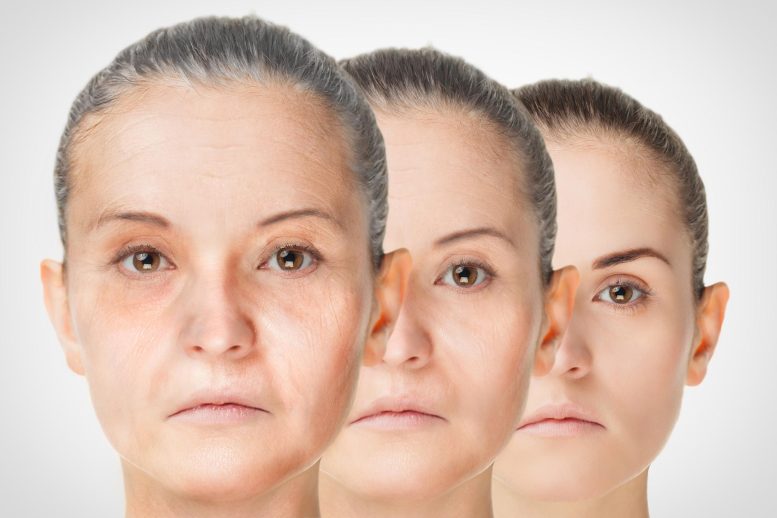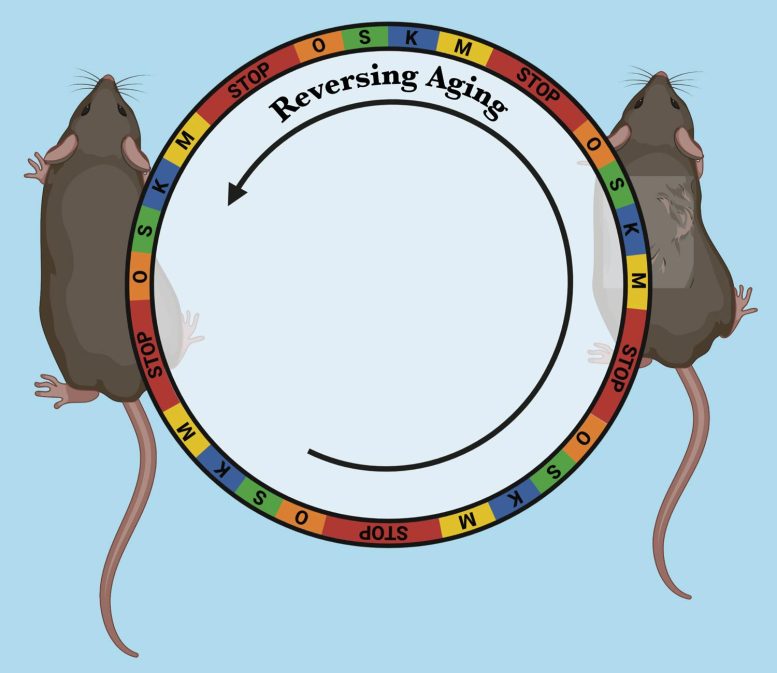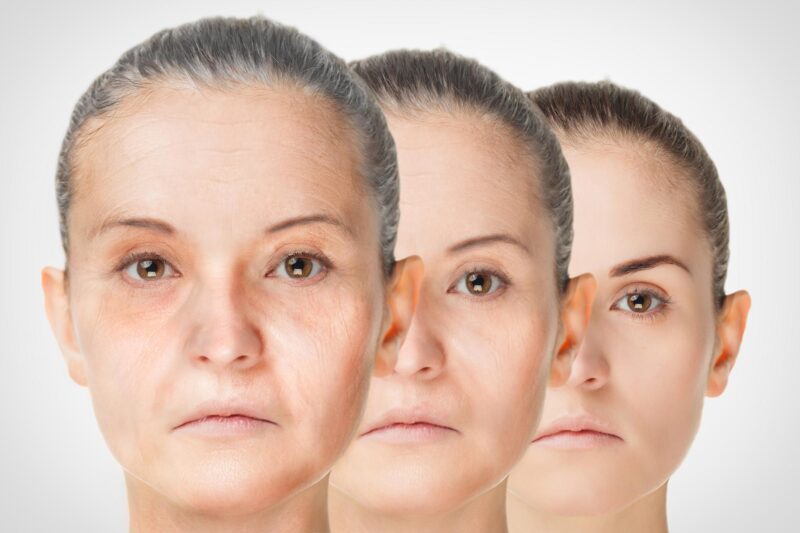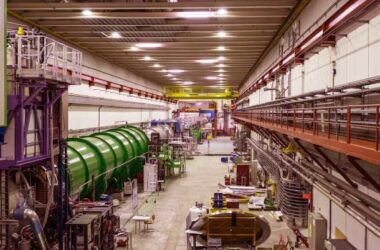
Concept d’artiste anti-âge.
Les chercheurs de Salk ont traité des souris avec un régime anti-âge à partir de l’âge moyen et n’ont constaté aucune augmentation du nombre de cancers ou d’autres problèmes de santé par la suite.
L’âge n’est peut-être qu’un chiffre, mais c’est un chiffre qui entraîne souvent des effets secondaires indésirables, allant de la fragilité des os et de l’affaiblissement des muscles à l’augmentation des risques de maladies cardiovasculaires et de cancer. Aujourd’hui, des scientifiques du Salk Institute, en collaboration avec Genentech, membre du groupe Roche, ont montré qu’ils pouvaient inverser de manière sûre et efficace le processus de vieillissement chez des souris d’âge moyen ou avancé en ramenant partiellement leurs cellules à un état plus jeune.
“Nous sommes ravis de pouvoir utiliser cette approche tout au long de la vie pour ralentir le vieillissement chez les animaux normaux. La technique est à la fois sûre et efficace chez la souris”, déclare le coauteur Juan Carlos Izpisua Belmonte, professeur au Gene Expression Laboratory de Salk et titulaire de la chaire Roger Guillemin. “En plus de s’attaquer aux maladies liées à l’âge, cette approche pourrait fournir à la communauté biomédicale un nouvel outil pour restaurer la santé des tissus et des organismes en améliorant la fonction et la résilience des cellules dans différentes situations pathologiques, comme les maladies neurodégénératives.”
Lorsque les organismes vieillissent, ce n’est pas seulement leur apparence extérieure et leur santé qui changent ; chaque cellule de leur corps porte une horloge moléculaire qui enregistre le passage du temps. Les cellules isolées de personnes ou d’animaux âgés présentent différents schémas de substances chimiques le long de leur DNA—called epigenetic markers—compared to younger people or animals. Scientists know that adding a mixture of four reprogramming molecules—Oct4, Sox2, Klf4, and cMyc, also known as “Yamanaka factors”—to cells can reset these epigenetic marks to their original patterns. This approach is how researchers can dial back adult cells, developmentally speaking, into stem cells.

Cellular rejuvenation therapy safely reverses signs of aging in mice. Credit: Salk Institute
In 2016, Izpisua Belmonte’s lab reported for the first time that they could use the Yamanaka factors to counter the signs of aging and increase life span in mice with a premature aging disease. More recently, the team found that, even in young mice, the Yamanaka factors can accelerate muscle regeneration. Following these initial observations, other scientists have used the same approach to improve the function of other tissues like the heart, brain and optic nerve, which is involved in vision.
In the new study, Izpisua Belmonte and his colleagues tested variations of the cellular rejuvenation approach in healthy animals as they aged. One group of mice received regular doses of the Yamanaka factors from the time they were 15 months old until 22 months, approximately equivalent to age 50 through 70 in humans. Another group was treated from 12 through 22 months, approximately age 35 to 70 in humans. And a third group was treated for just one month at age 25 months, similar to age 80 in humans.
“What we really wanted to establish was that using this approach for a longer time span is safe,” says Pradeep Reddy, a Salk staff scientist and co-first author of the new paper. “Indeed, we did not see any negative effects on the health, behavior or body weight of these animals.”

From left: Juan Carlos Izpisua Belmonte and Pradeep Reddy. Credit: Salk Institute
Compared to control animals, there were no blood cell alterations or neurological changes in the mice that had received the Yamanaka factors. Moreover, the team found no cancers in any of the groups of animals.
When the researchers looked at normal signs of aging in the animals that had undergone the treatment, they found that the mice, in many ways, resembled younger animals. In both the kidneys and skin, the epigenetics of treated animals more closely resembled epigenetic patterns seen in younger animals. When injured, the skin cells of treated animals had a greater ability to proliferate and were less likely to form permanent scars—older animals usually show less skin cell proliferation and more scarring. Moreover, metabolic molecules in the blood of treated animals did not show normal age-related changes.
This youthfulness was observed in the animals treated for seven or 10 months with the Yamanaka factors, but not the animals treated for just one month. What’s more, when the treated animals were analyzed midway through their treatment, the effects were not yet as evident. This suggests that the treatment is not simply pausing aging, but actively turning it backwards—although more research is needed to differentiate between the two.
The team is now planning future research to analyze how specific molecules and genes are changed by long-term treatment with the Yamanaka factors. They are also developing new ways of delivering the factors.
“At the end of the day, we want to bring resilience and function back to older cells so that they are more resistant to stress, injury and disease,” says Reddy. “This study shows that, at least in mice, there’s a path forward to achieving that.”
Reference: “In vivo partial reprogramming alters age-associated molecular changes during physiological aging in mice” by Kristen C. Browder, Pradeep Reddy, Mako Yamamoto, Amin Haghani, Isabel Guillen Guillen, Sanjeeb Sahu, Chao Wang, Yosu Luque, Javier Prieto, Lei Shi, Kensaku Shojima, Tomoaki Hishida, Zijuan Lai, Qingling Li, Feroza K. Choudhury, Weng R. Wong, Yuxin Liang, Dewakar Sangaraju, Wendy Sandoval, Concepcion Rodriguez Esteban, Estrella Nuñez Delicado, Pedro Guillen Garcia, Michal Pawlak, Jason A. Vander Heiden, Steve Horvath, Heinrich Jasper and Juan Carlos Izpisua Belmonte, 7 March 2022, Nature Aging.
DOI: 10.1038/s43587-022-00183-2
Belmonte is currently an Institute Director at Altos Labs, Inc., in addition to being a professor at the Salk Institute.
Other authors included Mako Yamamoto, Isabel Guillen Guillen, Sanjeeb Sahu, Chao Wang, Yosu Luque, Javier Prieto, Lei Shi, Kensaku Shojima, Tomoaki Hishida and Concepcion Rodriguez Esteban of Salk; Kristen Browder, Zijuan Lai, Qingling Li, Feroza Choudhury, Weng Wong, Yuxin Liang, Dewakar Sangaraju, Wendy Sandoval, Michal Pawlak, Jason Vander Heiden and Heinrich Jasper of Genentech, Inc.; Amin Haghani and Steve Horvath of UCLA; Estrella Nuñez Delicado of Universidad Católica San Antonio de Murcia; and Pedro Guillen Garcia of Clínica CEMTRO.
The study was supported by Universidad Católica San Antonio de Murcia (UCAM), and Fundación Dr. Pedro Guillén.



